Windows Phone 7.5 "Mango" - Mobile IE 9 Browser Explored
by Brian Klug on May 26, 2011 5:06 AM EST- Posted in
- Smartphones
- Windows Phone 7
- Mobile
- WP7
- Mango
- NoDo
- IE9
Yesterday Microsoft announced a number of details and the first official look at the next release of Windows Phone 7, codename “mango.”
Back when we reviewed Windows Phone 7 (henceforth WP7), we were impressed by the platform’s overall smoothness, appearance, and unique mobile paradigm, but highlighted a number of chief areas that needed improvement for it to be competitive with much more mature smartphone rivals. Copy and paste support was the first thing that we (and many others) talked about, which was included in the NoDo update which just rolled out to all WP7 devices.
The next major areas were multitasking (and fast application switching), addition of more APIs for developers, and finally, additional improvements to the browser. Though we praised the initial WP7 browser for having an incredibly smooth UI, it ultimately lacked robust web standards compliance thanks to its use of the obsolete IE 7 trident 3.1 layout engine. Back when WP7 was announced, IE9 was little more than a technical preview - since then it’s seen desktop launch, and corresponding development efforts to port it to WP7. Today we were given our first glimpse of the new browser in Mango, based on on the trident 5.0 layout engine, same as shipped with IE 9.
There are a number of improvements in Windows Phone 7.5 “mango,” and before we dive into ones related to the browser it does bear going over all of them. First off, Microsoft has categorized improvements into three umbrellas that it considers areas of core functionality for the platform - communications, applications, and finally internet and our browser.
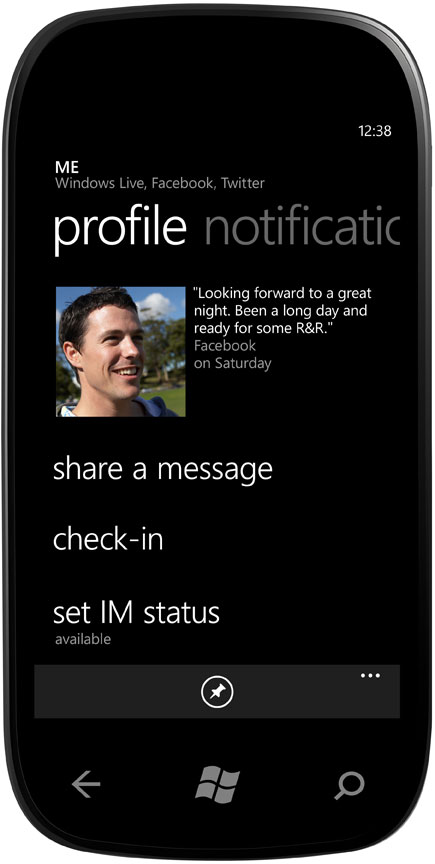
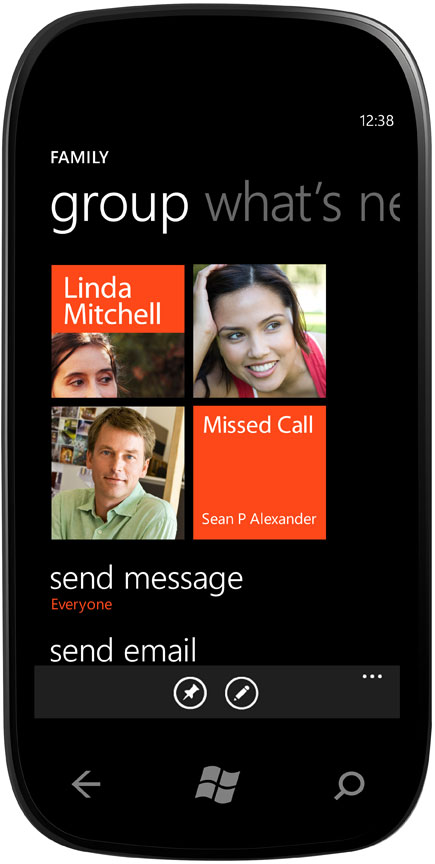
Left: The new people tab contact card showing Windows Live, Facebook, and Twitter integration. Right: New groups tab allowing quick inspection of any number of selected contacts
The first arm of improvements under communications is the new inclusion of Twitter, LinkedIn, and Windows Live Messenger data into each contact on the people hub. WP7 already included considerable amounts of Facebook data inclusion, now Facebook facial recognition, tags, and location check ins are supported as well. There’s a concept called groups that allows multiple contacts to be selected and placed in a live tile.

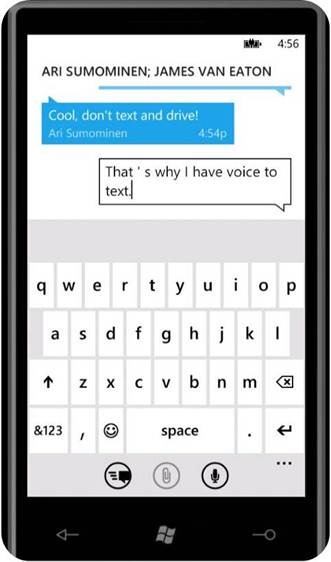
Left: Threaded messaging continuing from SMS to Facebook chat. Right: Voice to text recognition for messaging.
Along those lines, messaging in WP7 now includes a concept originally explored by WebOS. It’s called ‘threads,’ and it’s a mashup of IM and SMS for seamless conversation transition from mobile to the desktop. If a user is offline, SMS is default, if they’re on a supported IM service, the option to send an IM instead is selected. Windows Live messenger and Facebook chat are supported for IM, unfortunately there’s no mention of Google Talk or AIM being included. Right along those lines is inclusion of a text to speech engine for reading incoming messages out loud, and even more interesting is speech to text for composing and replying to messages. It’s clear that voice recognition tech is going to be a central feature for the next major version of each next smartphone OS.
One of the other things we wanted in WP7 and touched on in our review was that outlook on WP7 needed threaded email conversation support. This is included in the mango update as well, and threads can now be deleted, marked as read, and the like. Also included in outlook is multiple account linking and live tiles for individual inboxes.
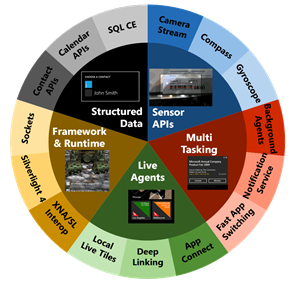
Under the category of applications are numerous new APIs, including support for a number of capabilities that developers requested going all the way back to MIX10. Back then I remember a number of sessions where developers were disappointed that WP7 wouldn’t initially have a number of things. Things like network socket creation - which is necessary for building applications like VoIP that require direct network access. Local SQL CE databases for storage and use in programs, and APIs for compass, gyro, and direct camera access, and APIs for contacts and calendars. Those are now very much a part of Mango, as discussed at MIX11. It’s clear that Microsoft was listening, even if it took just over a year for everything to come together.
Adding APIs isn’t something that results in immediately realizable features for end users, but enables developers to finally start porting applications on iOS and Android that leverage similar APIs. Skype and other VoIP applications for example would leverage socket support, as would streaming music protocols that can’t simply tunneled over HTTP, or video chat applications. Having a direct camera API enables augmented reality applications and third party camera apps as well - the end result is that with Mango WP7.5 is finally coming close to having the same level of API support as its more mature competitors.

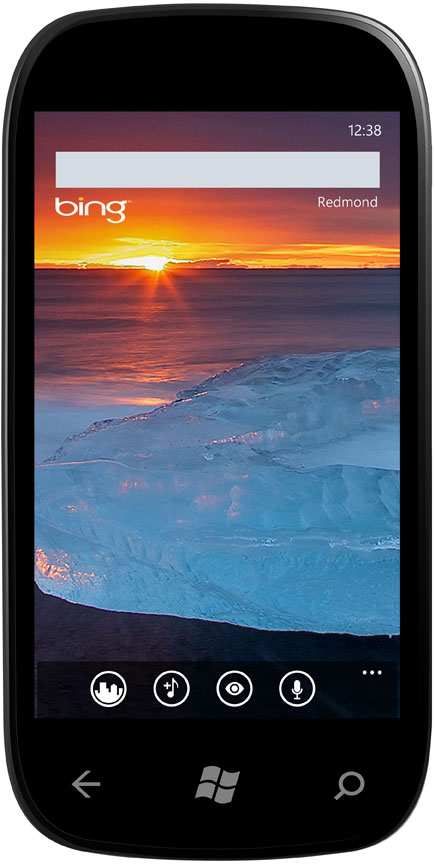
Microsoft showed off some demos of how Bing uses the camera API to search using live images of objects, in essence a Google Goggles for Bing - it calls this feature visual search. Likewise, music search is a clear nod to Shazam and enables music identification using a new sensor API for microphone access. In addition a number of improvements to Bing are coming in Mango, including improved local search.
The third and final tier of improvements in Mango is Internet. It shouldn’t come as any surprise that internet is such an important part of any smartphone platform that it earned its own category.










35 Comments
View All Comments
KZ0 - Friday, May 27, 2011 - link
You should try out Opera Mobile. I've been using Mobile since my first smartphone (stock Symbian browser isn't in the same league), Mini some years before that. Impressive how they actually made the web accessible without mouse / touchscreen, on a 176×220 display. Almost as much of an improvement as Opera 9 was over IE6, from my experience.Leonick - Saturday, May 28, 2011 - link
"The result is that there’s now more screen area dedicated to actual browsing, something I think other mobile browser still need to pay attention to. "Safari on the iPhone always only had a bottom bar with common buttons like back,forward, bookmarks and such, the address bar is at the top but hides when the page is finished loading...
Don't quite know how the default android one is, I've only really seen the browser on the SE x10 mini pro and X8 (not a whole lot on other phones) and I have a feeling they aren't quite default...
As for the html5test.com and acid3 test, the improvement is rather impressive, seems MS is doing some good work, however, Mobile Safari is 76 points and 2 bonus points ahead in the the html5 test (surprising seeing how Safari is pretty bad at HTML5 animations at least) and gets a solid 100 from acid3 (and android probably does too, as their default should be using webkit too as chrome and safari does)...
It's a big improvement, no denying that, still far behind though.
Are there any custom browsers for WP7 that use their own rendering engine? Would help a lot when the default is so far behind.
talzara - Monday, May 30, 2011 - link
Most browser backends are C++ based. Since nobody gets to write native code on Windows Phone except for Microsoft and the OEMs, it's unlikely that we'll see a new browser backend any time soon. Unless Nokia feels like doing one.Microsoft's position on Acid3 is that any score above 95 is meaningless, since the other 5 points come from transitional specs that will probably not end up in the final standard. See: http://blogs.msdn.com/b/ie/archive/2010/08/04/html...
asad.khan87 - Tuesday, June 14, 2011 - link
Does the Mango aka WP 7.5 update provide Bluetooth file transfer and USB Mass Storage(since pdf, doc, txt, etc. documents cannot be transferred using Zune) features? I am thinking about getting a HTC HD7 if these things are taken care of.ShakaraEP - Sunday, January 1, 2012 - link
Just got Samsung Focus with WP 7.5. I was very happy with the transition from iOS until I discovered that I cannot read Arabic websites. Probably not a problem for many, but seems short-sited from Microsoft given that there are 300 million Arabs out there.Will likely abandon this OS if support doesn't come quickly.